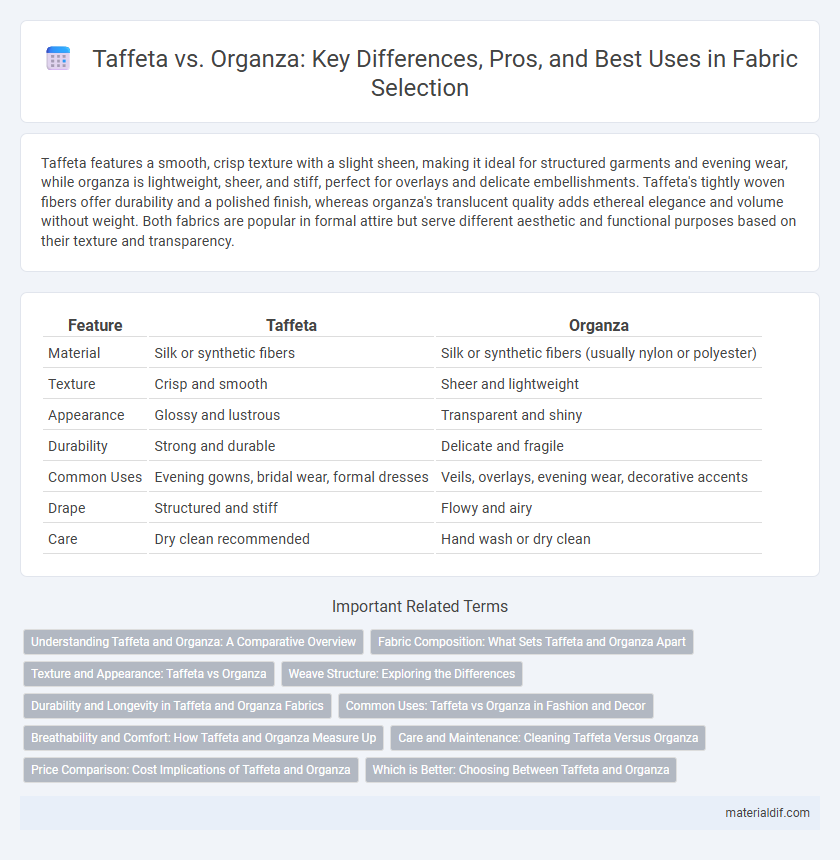Taffeta features a smooth, crisp texture with a slight sheen, making it ideal for structured garments and evening wear, while organza is lightweight, sheer, and stiff, perfect for overlays and delicate embellishments. Taffeta's tightly woven fibers offer durability and a polished finish, whereas organza's translucent quality adds ethereal elegance and volume without weight. Both fabrics are popular in formal attire but serve different aesthetic and functional purposes based on their texture and transparency.
Table of Comparison
| Feature | Taffeta | Organza |
|---|---|---|
| Material | Silk or synthetic fibers | Silk or synthetic fibers (usually nylon or polyester) |
| Texture | Crisp and smooth | Sheer and lightweight |
| Appearance | Glossy and lustrous | Transparent and shiny |
| Durability | Strong and durable | Delicate and fragile |
| Common Uses | Evening gowns, bridal wear, formal dresses | Veils, overlays, evening wear, decorative accents |
| Drape | Structured and stiff | Flowy and airy |
| Care | Dry clean recommended | Hand wash or dry clean |
Understanding Taffeta and Organza: A Comparative Overview
Taffeta is a crisp, smooth woven fabric often made from silk or synthetic fibers, known for its lustrous sheen and sturdy texture, frequently used in evening wear and formal gowns. Organza, a lightweight, sheer fabric crafted from silk or polyester, features a delicate, airy quality with a subtle shimmer, making it ideal for overlays and bridal attire. Understanding the differences in texture, weight, and transparency between taffeta and organza helps designers select the appropriate fabric based on the desired structure and visual effect.
Fabric Composition: What Sets Taffeta and Organza Apart
Taffeta is a smooth, tightly woven fabric typically made from silk, polyester, or nylon fibers, characterized by its crisp texture and subtle sheen. Organza, on the other hand, is a lightweight, sheer fabric usually crafted from silk or synthetic fibers like polyester, known for its transparent and stiff quality. The distinct fiber content and weave techniques of taffeta and organza directly influence their texture, weight, and visual appeal.
Texture and Appearance: Taffeta vs Organza
Taffeta has a smooth, crisp texture with a subtle sheen, creating a structured and elegant appearance ideal for formalwear and evening gowns. Organza features a lightweight, sheer texture with a slightly stiff hand, giving a delicate, airy look that adds volume and lightness to garments. Taffeta's tightly woven fibers contrast with organza's open weave, resulting in distinctly different draping and visual effects.
Weave Structure: Exploring the Differences
Taffeta features a plain weave structure with a tight, crisp texture created by tightly woven warp and weft yarns, giving it a smooth, lustrous surface. Organza employs a plain weave as well but is made from finer, thinner threads, resulting in a sheer, lightweight, and stiff fabric often used in overlays or delicate garments. The difference in weave density and yarn thickness between taffeta and organza creates contrasting fabric weights and translucency, influencing their respective applications in fashion and decor.
Durability and Longevity in Taffeta and Organza Fabrics
Taffeta fabric is known for its durability due to its tightly woven, crisp texture, making it resistant to wear and suitable for long-lasting garments. Organza, while lightweight and sheer, tends to be more delicate and prone to snagging, which can affect its longevity compared to taffeta. Choosing taffeta over organza ensures greater durability and extended fabric life, especially for structured garments and formal wear.
Common Uses: Taffeta vs Organza in Fashion and Decor
Taffeta is commonly used in evening gowns, bridal wear, and formal dresses due to its crisp texture and lustrous finish, providing structure and elegance. Organza is favored for overlays, veils, and decorative accents in haute couture and wedding attire, offering a sheer and lightweight appearance that adds volume without heaviness. In home decor, taffeta serves well in drapery and upholstery for a polished look, while organza is popular for delicate curtains and decorative ribbons, enhancing visual softness.
Breathability and Comfort: How Taffeta and Organza Measure Up
Taffeta, a tightly woven fabric made from silk or synthetic fibers, offers moderate breathability but tends to be stiffer and less comfortable against the skin compared to organza. Organza, known for its lightweight and sheer qualities, provides superior breathability, allowing air to flow freely and making it more comfortable for extended wear in warm conditions. Both fabrics are elegant, but organza's high permeability and soft texture make it ideal for garments prioritizing comfort and ventilation.
Care and Maintenance: Cleaning Taffeta Versus Organza
Taffeta requires gentle dry cleaning or hand washing with mild detergent to maintain its crisp texture and sheen, avoiding high heat that can cause damage. Organza, being more delicate and sheer, demands careful dry cleaning and minimal handling to prevent tears and retain its stiffness. Both fabrics benefit from low-temperature ironing and proper storage in a cool, dry environment to preserve their integrity and appearance.
Price Comparison: Cost Implications of Taffeta and Organza
Taffeta generally costs more than organza due to its dense weave and heavier weight, making it ideal for structured garments and eveningwear. Organza, being lighter and sheer, is often less expensive, allowing for cost-effective options in delicate overlays and decorative details. When budgeting for fabric, consider the project's design and durability requirements alongside the varying price points of taffeta and organza.
Which is Better: Choosing Between Taffeta and Organza
Taffeta offers a smooth, crisp texture ideal for structured garments and evening wear, while organza provides a lightweight, sheer quality perfect for overlays and delicate designs. The choice between taffeta and organza depends on the desired fabric stiffness and transparency, with taffeta being more durable and organza offering an ethereal appearance. For formal dresses and upholstery, taffeta excels in body and shine, whereas organza suits intricate detailing and a softer silhouette.
Taffeta vs Organza Infographic

 materialdif.com
materialdif.com